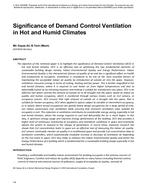Description
The objective of this technical paper is to highlight the significance of Demand Control Ventilation (DCV) inhot and humid climates. DCV is an effective tool of optimizing the two fundamental elements ofsustainable building design namely, Indoor Environmental Quality and Energy Performance. IndoorEnvironmental Quality is the characteristic feature of quality of air and has a significant effect on healthand productivity of occupants. Ventilation is considered to be one of the most essential factors ofmaintaining the acceptable indoor air quality by introduction of outside air into the space. However,ventilation consumes energy in terms of cooling, heating and fan power. This is further magnified in hotand humid climates, where it is required to cool hotter air from higher temperatures and also todehumidify humid air by removing moisture and making it suitable for introduction into space. DCV is aneffective tool which controls the amount of outside air to be brought into the space, based on indoor airquality and human occupancy, which is monitored through various means such as CO2 sensors, oroccupancy sensors. DCV ensures that right amount of outside air is brought into the space, that issuitable for human occupancy. DCV when applied in spaces subject to variable or intermittent occupancy,or in spaces where actual occupancies are greatly below design occupancies for a large period of time,can reduce unnecessary over ventilation while ensuring that minimum ventilation rates suitable foroccupants is met. This reduction in ventilation contributes to considerable energy saving, especially in hotand humid climates, where the energy required to cool and dehumidify the air is much higher. In thisway, it optimizes energy usage and improves Energy performance of the building. DCV also provides ahigher level of continuous monitoring of occupancy and ventilation conditions in space and constantlyadjusts the system to respond to the change of parameters. In recent times, extensive research hasshown that CO2 concentration levels in space are an effective tool of measuring the indoor air quality.CO2 sensors continually monitor air quality in a conditioned space and provide CO2 concentration data toventilation controllers, which automatically modulate increase or decrease of ventilation air dependingon the CO2 levels in space. DCV thus helps to enhance the Indoor Environmental quality and better theEnergy Performance of a building which is fundamental for a sustainable building design especially in hotand humid climates.
Citation: First International Conference on Energy and Indoor Environment for Hot Climates, Doha, Qatar, February 2014
Product Details
- Published:
- 2014
- Number of Pages:
- 8
- File Size:
- 1 file , 1.4 MB
- Product Code(s):
- D-2014FICEConf-9-2




